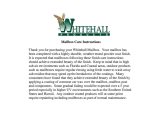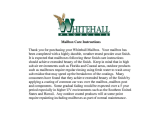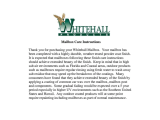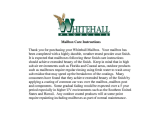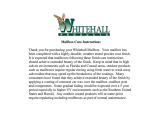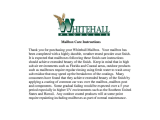Page is loading ...

Version 4.3 for Windows
User Manual

This manual was written for use with the Eudora® for Windows software version 4.3. This manual and the Eudora
software described in it are copyrighted, with all rights reserved. This manual and the Eudora software may not
be copied, except as otherwise provided in your software license or as expressly permitted in writing by QUAL-
COMM Incorporated.
Copyright © 2000 by QUALCOMM Incorporated. All rights reserved.
Eudora is a registered trademark of QUALCOMM Incorporated.
PureVoice and SmartRate are trademarks of QUALCOMM Incorporated.
WorldMail is a trademark of QUALCOMM Incorporated.
QUALCOMM is a registered trademark and registered service mark of QUALCOMM Incorporated.
Microsoft, Outlook, and Windows are either registered trademarks or trademarks of Microsoft Incorporated in the
United States and/or other countries.
Adobe, Acrobat, and Acrobat Exchange are registered trademarks of Adobe Systems Incorporated.
Apple and the Apple logo are registered trademarks, and QuickTime is a trademark of Apple Computer, Inc.
Netscape, Netscape Communicator, and Netscape Messenger are registered trademarks of the Netscape Commu-
nications Corporation in the United States and other countries. Netscape's logos and Netscape product and service
names are also trademarks of Netscape Communications Corporation, which may be registered in other countries.
All other trademarks and service marks are the property of their respective owners.
Use of the Eudora software and other software and fonts accompanying your license (the "Software") and its doc-
umentation are governed by the terms set forth in your license. Such use is at your sole risk. The Software and its
documentation (including this manual), and QUALCOMM's software maintenance and extended maintenance, if
applicable, are provided "AS IS" and without warranty of any kind and QUALCOMM AND ITS LICENSORS
(HEREINAFTER COLLECTIVELY REFERRED TO AS "QUALCOMM") EXPRESSLY DISCLAIM ALL
WARRANTIES, EXPRESS OR IMPLIED, INCLUDING, BUT NOT LIMITED TO THE IMPLIED WARRAN-
TIES OF MERCHANTABILITY AND FITNESS FOR A PARTICULAR PURPOSE AND AGAINST IN-
FRINGEMENT. QUALCOMM DOES NOT WARRANT THAT THE FUNCTIONS CONTAINED IN THE
SOFTWARE WILL MEET YOUR REQUIREMENTS, OR THAT THE OPERATION OF THE SOFTWARE
WILL BE UNINTERRUPTED OR ERROR-FREE, OR THAT DEFECTS IN THE SOFTWARE WILL BE
CORRECTED. FURTHERMORE, QUALCOMM DOES NOT WARRANT OR MAKE ANY REPRESENTA-
TIONS REGARDING THE USE OR THE RESULTS OF THE USE OF THE SOFTWARE OR ITS DOCU-
MENTATION IN TERMS OF THEIR CORRECTNESS, ACCURACY, RELIABILITY, OR OTHERWISE. NO
ORAL OR WRITTEN INFORMATION OR ADVICE GIVEN BY QUALCOMM OR A QUALCOMM AU-
THORIZED REPRESENTATIVE SHALL CREATE A WARRANTY OR IN ANY WAY INCREASE THE
SCOPE OF THIS WARRANTY. SOME JURISDICTIONS DO NOT ALLOW THE EXCLUSION OF IM-
PLIED WARRANTIES, SO THE ABOVE EXCLUSION MAY NOT APPLY.
UNDER NO CIRCUMSTANCES INCLUDING NEGLIGENCE, SHALL QUALCOMM, ITS LICENSORS OR
THEIR DIRECTORS, OFFICERS, EMPLOYEES OR AGENTS BE LIABLE FOR ANY INCIDENTAL, SPE-
CIAL OR CONSEQUENTIAL DAMAGES (INCLUDING DAMAGES FOR LOSS OF BUSINESS, LOSS OF
PROFITS, BUSINESS INTERRUPTION, LOSS OF BUSINESS INFORMATION AND THE LIKE) ARISING
OUT OF THE USE OR INABILITY TO USE THE SOFTWARE OR ITS DOCUMENTATION, EVEN IF
QUALCOMM OR A QUALCOMM AUTHORIZED REPRESENTATIVE HAS BEEN ADVISED OF THE

POSSIBILITY OF SUCH DAMAGES. SOME JURISDICTIONS DO NOT ALLOW THE LIMITATION OR
EXCLUSION OF LIABILITY FOR INCIDENTAL OR CONSEQUENTIAL DAMAGES SO THE ABOVE
LIMITATION OR EXCLUSION MAY NOT APPLY.
In no event shall QUALCOMM’s total liability to you for all damages, losses, and causes of action (whether in
contract, tort, including negligence, or otherwise) exceed the amount paid for the Software and its documentation.
Acknowledgments
The Eudora software was designed and developed by Jeff Beckley, Rob Chandhok, Steve Dorner (original author
of Eudora) Joel King, Sameer Jindal, Sudheer Koganti, Scott Manjourides, Brian Minear, Subhashis Mohanty,
Apul Nahata, Ben Ogdon, Bill Rhodes, Jim Riley, Joshua Stephens, Kerthi Sundormurthy, Kusuma Vellanki,
Geoff Wenger, and Dale Wiggins. The software was quality assured by David Hom, Gwen Huntley, Kolar Ma-
hesh, Jason Miller, and Sean Rogers. This manual was written by Armand Rouleau. Thanks to all the users and
testers of Eudora, whose suggestions have made it a much better program than it otherwise would have been.
About the Name
Why the name Eudora?
When looking for a name for this new Post Office Protocol mail program, we thought immediately of the title of
the short story “Why I Live at the P.O.,” and named the program after the author of the story, Eudora Welty.
“Why I Live at the P.O.” can be found in a collection entitled A Curtain of Green and Other Stories (Harcourt
Brace & Co.). Ms. Welty’s stories are funny, sad, and fascinating; she’s surely one of the great American writers.
February 2000
PM80-48070-3 revA


5
QUALCOMM Incorporated
Contents
Click the topic or page number to display the topic.
Introducing Eudora® Email 13
What’s New in Eudora Email 4.3 13
Eudora Email vs. Postal Mail 13
Where Do I Find Information? 14
Eudora Quick Start Guide 15
Online Help 15
Context Sensitive Help 15
Help Topics 16
Tip of the Day 16
About Eudora 16
Operating Eudora in One of Three Modes 16
Changing Eudora Modes 17
Registering Eudora 18
Technical Support
(Sponsored and Paid modes only) 18
Starting and Quitting Eudora 19
Creating Messages 21
Creating an Outgoing Message 21
Using the Composition Window 21
Title Bar 21
Text Toolbar 21
Message Header 25
Message Body 26
Using Automatic Name Completion
(Sponsored and Paid modes only) 26
Setting the Message Priority 27
Requesting a Return Receipt
(Sponsored and Paid modes only) 28
Formatting Text
(Sponsored and Paid modes only) 29
Text Editing Menu Commands 30
Other Formatting Options 31
Inserting Objects in Message Text
(Sponsored and Paid modes only) 31
Attaching a File to a Message 32
Manually Decoding Attachments 33
Attaching a PureVoice™ File to a Message 33
Including a URL in a Message
(Sponsored and Paid modes only) 34
Creating a Hyperlink in a Message
(Sponsored and Paid modes only) 34

Contents
6
QUALCOMM Incorporated
Checking Your Spelling Automatically
(Sponsored and Paid modes only) 35
Checking Your Spelling Manually
(Sponsored and Paid modes only) 37
Check Spelling Dialog Box 38
Saving a Message for Later Changes 41
Sending Messages and Checking Mail 43
Sending or Queueing a Message 43
Sending a Message Immediately 43
Queueing a Message to Send Later 43
Queueing a Message to Send at a Certain Time 44
Editing a Queued Message 45
Taking a Message Out of the Queue 45
Sending Queued Messages When Checking Mail 45
Sending Messages with Special Server Instructions 46
Using SMTP Authentication 46
Keeping Copies of Outgoing Messages 47
Checking for Incoming Mail 47
Checking for Mail Automatically 47
Checking for Mail Manually 48
Stopping a Mail Check 48
Using Your Password 49
Changing Your Password 50
Receiving and Responding to Messages 51
Receiving New Mail 51
Incoming Message Window 51
Title Bar 52
Toolbar 52
Message Body 53
Printing an Incoming Message 53
Receiving Attachments 53
Specifying an Attachment Directory 54
Editing Incoming Messages 55
Using Active URLs
(Sponsored and Paid modes only) 55
Managing Your Mail on the POP Server 55
Leaving Mail on the Server 56
Deleting a Message from the Server 57
Skipping Messages Over a Certain Size 57
Checking for Mail with Special Server Instructions 57
Managing Your Mail on the IMAP Server 59
Downloading Minimal Headers vs. the Full Message 59
Full Message Except Attachments Over _ K 60
Deleting a Message from the Server 60
Resynchronizing an IMAP Mailbox or Folder 61
Refreshing Your List of IMAP Mailboxes and Folders 62
Using IMAP Tasks Offline 62
Replying to a Message 63

Contents
7
QUALCOMM Incorporated
Using the Reply Options 63
Reply with Selected Text 64
Forwarding a Message 64
Redirecting a Message 65
Turbo Redirecting 65
Redirect and Signatures 66
Sending Rejected Messages Again 66
Using Signatures and Stationery 67
Using a Signature 67
Signature Window 67
Adding a New Signature 68
Modifying a Signature 69
Deleting a Signature 69
Using a Signature in a Message 69
Using Stationery
(Sponsored and Paid modes only) 70
Stationery Window 70
Creating New Stationery 71
Modifying Stationery 72
Deleting Stationery 72
Using Stationery in a Message 72
Replying with Stationery
(Sponsored and Paid modes only) 73
Using Multiple Personalities (Sponsored and Paid modes only) 75
Using Alternate Email Accounts 75
Personalities Window 75
Adding a New Personality 77
Creating a New Personality 77
Importing Settings to Create a New Account 80
Adding a Personality via the Account Settings Dialog 83
Account Settings Dialog 83
Generic Properties 84
Incoming Mail 86
Modifying a Personality 88
Deleting a Personality 88
Linking a Signature and Stationery to a Personality 89
Selecting a Personality in a Message Header 90
Using a Personality in a Message 90
Working with Mailboxes 93
Opening a Mailbox 93
Understanding the Components of a Mailbox 93
Message Summaries 93
Status Column 95
Priority Column 96
Attachments Column 96
Label Column 96
Sender/Recipient Column (Who) 96
Date Column 97

Contents
8
QUALCOMM Incorporated
Size Column 97
Server Status Column 97
Subject Column 97
Displaying and Resizing Columns 98
Using the Mailbox Size Display 98
Message Preview Pane 99
Creating Mailboxes and Folders 100
Creating a Mailbox or Folder Using the Mailbox Menu 100
Using the Mailboxes Window 101
Creating a New Mailbox or Folder 102
Renaming a Mailbox or Folder 102
Moving a Mailbox from One Folder to Another 102
Removing a Mailbox or Folder 102
Mailbox and Folder Management: POP vs. IMAP 103
Organizing Your Messages 105
Deleting a Message 105
POP Procedure 105
IMAP Procedure 105
Automatically Deleting Attachments 106
Transferring Messages 106
Using the Transfer Menu 107
Dragging Messages 107
Creating a Mailbox or Folder During Transfer 107
Filtering Messages 108
Quick and Simple Filters with the Make Filter Command 108
Match Conditions 109
Action Area 110
Buttons 111
Detailed Filters with the Filters Window 111
Filter Criteria (Match Area) 113
Filter Actions 115
Creating an Auto-Reply Message
(Sponsored and Paid modes only) 117
Sorting Messages Within Mailboxes 117
Simple Sorting 118
Complex sorting 119
Using the Find Command 119
Finding Text Within One Message 119
Stopping a Find 120
Find Messages 120
Saving a Message to a File 126
Managing Windows in Eudora 129
Window States and Tabbed Windows 129
Normal Windows 130
Docked Windows 131
Gripper Bar 132
Zoom Button 132
Close Button 133
Resize Bar 133

Contents
9
QUALCOMM Incorporated
Floating Windows 133
Tabbed Windows 134
Eudora’s Default Tabbed Windows 135
Opening and Activating Tabbed Windows 136
Reorganizing Tabbed Windows 136
Creating a New Tabbed Window 137
Tab Display in Single-Tabbed Windows 137
Tab Contents, Location, Auto-Activation 137
Closing Tabbed Windows 138
Window Context Menu 138
Tab Location 138
Allow Docking 139
Hide 139
Float In Main Window 139
Eudora Toolbar 140
Viewing the Main Toolbar 141
Adding, Moving, and Removing Toolbar Buttons
(Sponsored and Paid modes only) 142
Adding Toolbar Buttons 142
Moving a Toolbar Button 144
Removing a Toolbar Button 144
Adding and Removing Separators 144
Eudora Taskbar 144
Main Window Icon 145
Filter Report Window 146
File Browser Window 148
Background Tasks (multi-threading) 150
Task Status Window 151
Task Error Window 152
Link History
(Sponsored and Paid modes only) 154
Using the Address Book 157
Creating an Address Book within your Address Book
(Sponsored and Paid modes only) 158
Adding an Address Book Entry 158
Changing, Moving, Copying, and Deleting Entries 160
Renaming a Nickname 161
Addressing a New Message from the Address Book 161
Make Address Book Entry Command 162
Finish Address Book Entry Command 164
Using Central Address Book Files on a Server 164
Using Address Book Files Not Created by Eudora 164
Using the Quick Recipient List 165
Including Nicknames on the Quick Recipient List 166
Using Directory Services 167
Opening Directory Services 167
Keeping the Directory Services Window on Top 168
Making a Query 168
Automatic Name Completion in Directory Services

Contents
10
QUALCOMM Incorporated
(Sponsored and Paid modes only) 168
Reading Query Results 169
Addressing a Message from the Directory Services Window 170
Making an Address Book Entry from Query Results 170
Printing Your Query Results 171
Considering the State of the Window 171
Using Directory Service Protocols 172
Using Directory Service Databases 172
Adding a New Database (Server) 173
Ph Database 173
Results List 175
Details List 175
Finger Database 176
LDAP Database 177
Modifying a Database 182
Deleting a Database 183
Using Menu Commands 185
Introduction 185
File Menu 185
Edit Menu 186
Mailbox Menu 188
Message Menu 189
Transfer Menu 190
Special Menu 191
Tools Menu 192
Window Menu 194
Help Menu 194
Setting Eudora Preferences 197
Introduction 197
Getting Started 197
Checking Mail 199
Incoming Mail 200
Sending Mail 203
Internet Dialup 205
Replying 206
Attachments 207
Fonts 208
Display 209
Viewing Mail 210
Mailboxes 212
Styled Text 213
Spell Checking
(Sponsored and Paid modes only) 215
Auto-Completion
(Sponsored and Paid modes only) 216
Date Display 218
Labels 219
Getting Attention 221

Contents
11
QUALCOMM Incorporated
Background Tasks 222
Automation 224
Extra Warnings 225
MAPI 227
Advanced Network 228
Auto Configure 230
Kerberos 231
Miscellaneous 231
Using Modifiers and Shortcuts 235
Eudora Modifiers 235
Eudora Shortcuts 236
General Reference 239
Right Mouse Button 239
Mail Storage 239
Plug-ins (Extended Messaging Services) 242
The Messaging Application Program Interface (MAPI) 243
Putting Multiple Users on One Computer 243
Mail Transport 245
Introduction 245
Outgoing Mail 245
Incoming Mail 246
More Information 246
MAPI Technical Report 247
Where to Get More Information on MAPI 247
What Does MAPI Do? 247
MAPI Overview 248
Eudora Implementation of MAPI 249
Eudora MAPI Startup Procedure 249
Eudora MAPI Shutdown Procedure 250
Eudora DLL Swapping Restrictions 250
MIME and Mapping 253
What Is MIME? 253
MIME Encoding 253
MIME Labeling 254
Practical Issues 254
Turning Off Quoted-Printable Encoding 255
Mapping Between File Extensions, MIME Types, and
Macintosh Types 255
Sources 257
Anonymous FTP (ftp.eudora.com) 257
Eudora Information 257
Obtaining an Internet Email Server 257
Ph Server Source Code 258
Password Change Server 258
Windows Sockets Products 258

Contents
12
QUALCOMM Incorporated
Kerberos 258
Spelling Dictionaries 258
Developer Information 258
Dialup Eudora 259
Introduction 259
General Steps 259
Configuring Dialup Networking under Windows 95/98 260
Configuring Dialup Networking using Windows NT 4.x 261
Defining a Login Script 262
Creating a Desktop Phonebook Shortcut 264
Configuring Eudora to Auto-Dial the Phonebook Entry 264
Eudora.ini File 267
EUDORA.INI Settings File 267
Optional Sections 267
Name and Location of the INI File 268
Default INI file 268
Settings 269
Mappings 278
Window Position 279
Tool Bar 279
Debug 282
Troubleshooting 283
What to Do First 283
Errors 283
Formatting and Printing 284
Miscellaneous 285
Glossary 287
Index 293

13
QUALCOMM Incorporated
Introducing Eudora
®
Email
Welcome to Eudora Email 4.3! Eudora Email, hereafter referred to as Eudora, is a
comprehensive electronic mail (email) software program that accesses your Internet
Service Provider (ISP) or network to receive and send your email messages.
In Eudora, you can write messages and send them with custom stationery and signatures.
You can send files, both text and graphic, created in other programs and "attach" them to
your email messages. You can forward messages, redirect them, or reply to all recipients
of a message.
You can set up mailboxes and folders for your mail and build "filters" to sort messages,
alert you, and even send an automatic reply.
All your favorite addresses can be stored in your personal address book, or you can let
Eudora search for addresses for you. And if you use more than one ISP, Eudora allows
you to build "multiple personalities" to send and receive mail to multiple accounts.
There are many more Eudora features and functions described later in this manual.
What’s New in Eudora Email 4.3
The following new features and functions have been added to Eudora in version 4.3.
■ Introducing Eudora in Three Modes. You can now choose which mode of Eudora is
best for you: Sponsored, Paid, or Light!
■ Importing from Outlook Express™. You may now import information and settings
from Microsoft® Outlook Express 5.0.
■ Super Sorting. You can now sort your messages in a mailbox by more than one sort
criteria or retain the sorted order for one column.
■ Group by Subject. You can now sort messages by grouping same subjects together.
■ Link History. Link history tracks and links Internet web site URLs, attachments, and
ads that you have clicked in Eudora.
Eudora Email vs. Postal Mail
Below is a comparison between Eudora email and postal mail.
Eudora Email Postal Mail
Mail is sent and received to and from
servers provided by your ISP or
network.
Mail is sent and received to and from
post offices provided by your
government.
Mail is transported using servers. Mail is transported using trucks, trains,
and planes.

Eudora User Manual Where Do I Find Information?
14
QUALCOMM Incorporated
Where Do I Find Information?
If you can’t find the information you are looking for in this user manual, it may be in the
Eudora Quick Start Guide, or in the online help program in Eudora. This user manual is an
online user manual; that is, it provides the basic procedures for using Eudora. The online
help is primarily procedures and definitions.
The manual’s topics are linked. When you see a page number associated to a topic in the
Table of Contents, the Index, or a cross-reference, just click the page number and the
topic appears.
If you prefer, you can print the PDF manual. From the File menu in Acrobat Reader,
choose Print.
Incoming server delivers mail to your
computer. This server uses the POP or
IMAP protocol.
Postal carrier delivers mail to your
home or office.
Your computer is your mailbox. You go to your mailbox.
Check for mail. Check for mail.
Mail is delivered to your In box.
However, you can have mail sorted
automatically to other mailboxes you set
up.
Mail is delivered to your mailbox.
However, you can sort your mail once
you receive it.
Look up an email address in your
address book.
Look up an address in your address
book.
Look up a person’s information using
Directory Services.
Look up a person’s information using
the white pages of the phone book.
To compose mail, you type on your
computer’s keyboard.
To compose mail, you type on your
computer’s keyboard or typewriter and
print it on paper. Or you write using a
pen on paper.
You enter header information, which
includes your recipient’s email address
and your return address.
You place the paper in the envelope
and write the person’s name, address,
and your return address.
You send mail to your outgoing server,
where it will be sent. This server uses
the SMTP protocol. This server creates
an “electronic envelope” for your email.
You stamp and send your mail to a post
office, where it will be processed and
sent.
Your recipient receives your mail
usually within a few minutes.
Your recipient receives your mail within
days, depending on location.
Eudora Email Postal Mail

Eudora User Manual Where Do I Find Information?
15
QUALCOMM Incorporated
Eudora Quick Start Guide
The Eudora Quick Start Guide is included in your Eudora product box and/or as an elec-
tronic file in you Eudora directory. The Quick Start Guide shows you how to install Eudora
and allows you to begin using the basic functions of Eudora immediately. The Guide
provides only simple descriptions, so for more details, refer to this document.
Information provided in the Eudora Quick Start Guide is as follows:
■ Finding Information
■ Getting Started
■ Installing Eudora
■ Opening and Configuring Eudora
■ Operating Eudora in One of Three Modes
■ Registering Eudora
■ Technical Support
■ Creating and Sending a Message
■ Checking and Receiving Mail
■ Setting up Automatic Mail Checking
■ Replying to a Message
■ Forwarding a Message
■ Redirecting a Message
■ Shortcuts
The functions listed above, except for Getting Started and the Eudora installation sections,
are described more thoroughly in this manual.
Online Help
There are several ways to get online Help with Eudora.
■ To find out what something on the screen does, use context-sensitive help.
■ For instruction on how to perform certain tasks, use the help topics.
■ To receive daily tips on assorted Eudora features each time you open Eudora, read the
Tip of the Day.
Context Sensitive Help
■ Choose Context Sensitive Help from the Help menu. Then click the item in question.
A brief description of the item appears. Click anywhere to close the description window.
■ Click the Help button . Then click the item in question. A brief description of the
item appears. Click anywhere to close the description window.

Eudora User Manual Operating Eudora in One of Three Modes
16
QUALCOMM Incorporated
■ Press the F1 key. Select the option, command or field item in Eudora you want to know
about, or use the Tab and arrow keys to move keyboard focus to that item. Then press
F1. Keyboard focus is indicated by a dashed highlight box, a highlighted entry or item,
or a flashing insertion cursor.
If the item is in a tabbed window, move the mouse arrow to a field and press F1. The
entire procedure for the window appears.
Help Topics
For instructions on how to do certain tasks, choose Topics from the Help menu. The Help
Contents are displayed, and you may either browse the contents or use the Find and
Index options.
For more information, see “Help Menu” on page 194. Click the page number to display the
topic.
Tip of the Day
After you set up Eudora, the Eudora Tip of the Day dialog box appears each time you
open Eudora showing you the Tip of the Day. You can display the following and previous
tips by clicking the Next Tip and Previous Tip buttons. To prevent the Tip of the Day
dialog box from being displayed on startup, uncheck the “Show Tips at Startup” check box.
You can always display the Tip of the Day from the Help menu.
To close the Tip of the Day dialog box, click the Close button.
About Eudora
About Eudora displays the software version, registration information, and the credits for
those who worked on or contributed to this version of Eudora.
Operating Eudora in One of Three Modes
You can choose one of three operating modes on how you wish to use Eudora. They are
as follows:
■ Paid mode
This mode provides the full-featured Eudora desktop email client without advertising.
■ Sponsored mode
This mode provides the full-featured Eudora desktop email client at no charge, supported
by sponsors' advertising. It includes all of the features that are in the Paid mode.
■ Light mode
This is an upgrade to the freeware version formerly known as Eudora Light. It includes
fewer features than the other modes and a sponsor image or logo.

Eudora User Manual Changing Eudora Modes
17
QUALCOMM Incorporated
Changing Eudora Modes
If you bought Eudora from a retail store or from a web site, Eudora installs in Paid mode.
However, if you would like to change the operating mode, for example to Sponsored
mode, you can do so right in the Eudora program. (Remember to request a refund from
QUALCOMM. See the last page of this guide for details.)
To change the Eudora operating mode after you install Eudora 4.3, do the following.
1 From the Help menu, choose Payment & Registration. The Payment and Registra-
tion window appears.
Payment and Registration Window
2 In the Which Eudora is right for you? section:
■ To use Eudora in Sponsored mode, click Sponsored Mode (free, with ads).
Eudora displays the ad window.
■ To use Eudora in Paid mode, click Paid Mode (costs money, no ads). Eudora
displays the Eudora web site for you to purchase Eudora.
■ To use Eudora in Light mode, click Light Mode (free, fewer features). Eudora
changes to Light mode by shutting down certain features. The features that will be
off are listed in the Light mode dialog.

Eudora User Manual Registering Eudora
18
QUALCOMM Incorporated
3 In the Keeping Current section:
■ To customize the ads, click Customize the Ads You See. Eudora displays a web
site where you can provide information about yourself to help in customizing which
ads should be displayed to you.
■ To find the most current version of Eudora, click Find the Latest Versions. The
Eudora web site displays where you can retrieve the latest version of Eudora.
Note. You can tell which mode you are in because that button is grayed out. To find out
more information about the modes, click Tell Me More About the Three Modes.
4 To exit the dialog box, click Close.
Registering Eudora
If you are using Eudora in either Sponsored or Paid mode, you need to register to be
eligible for technical support. If you don’t register or use Eudora in Light mode, you are not
eligible for technical support.
To register your copy of Eudora, do the following.
1 From the Help menu, choose Payment & Registration. The Payment and Registra-
tion window appears.
2 In the Keeping Current section, click Register with Us. Eudora takes you to Eudora’s
registration web page.
3 Enter your information, click Submit Registration. An email will be sent to you
confirming your registration.
Technical Support
(Sponsored and Paid modes only)
If you register your copy of Eudora in Sponsored or Paid mode, you are entitled to 90 days
of free technical support from the date of the first call. Be sure to register as soon as
possible to avoid any delays in receiving technical support.
Many common issues can be solved by visiting the Eudora technical support web site at:
<http://www.eudora.com/techsupport/Win>. The technical support web site
provides online answers to your technical questions about QUALCOMM’s Eudora soft-
ware products. Go to the Technical Support web site to get valuable “how to” information
and step-by-step interactive tutorials. Also, you will be able to retrieve most current
Eudora products and documentation. (Light mode users may use the Eudora web site
technical support and tutorials.)
If you are unable to find your answer using the technical support web site, Eudora tech
support reps are available Monday - Friday from 8 a.m. to 5 p.m. Pacific Time using the
following phone number and email address:
Phone: (858) 658-1292
Email: eudora-support@eudora.com

Eudora User Manual Starting and Quitting Eudora
19
QUALCOMM Incorporated
Starting and Quitting Eudora
To start Eudora, do the following.
1 From the Start menu under Programs, choose Eudora
2 Choose Eudora again. Eudora launches.
To quit Eudora, do the following.
1 From the File menu, choose Exit or press Ctrl+Q. Eudora closes.
If you have queued messages or timed messages due to be sent in the next 12 hours, you
are given the option to send them. See the sections “Queuing a Message to Send Later”
on page 43 and “Queueing a Message to Send at a Certain Time” on page 44. Click the
page number to display the topic.
The Trash mailbox is emptied if the “Empty Trash when exiting” option is selected in the
Miscellaneous options. See “Miscellaneous” on page 231. Click the page number to
display the topic.

Eudora User Manual Starting and Quitting Eudora
20
QUALCOMM Incorporated
/
